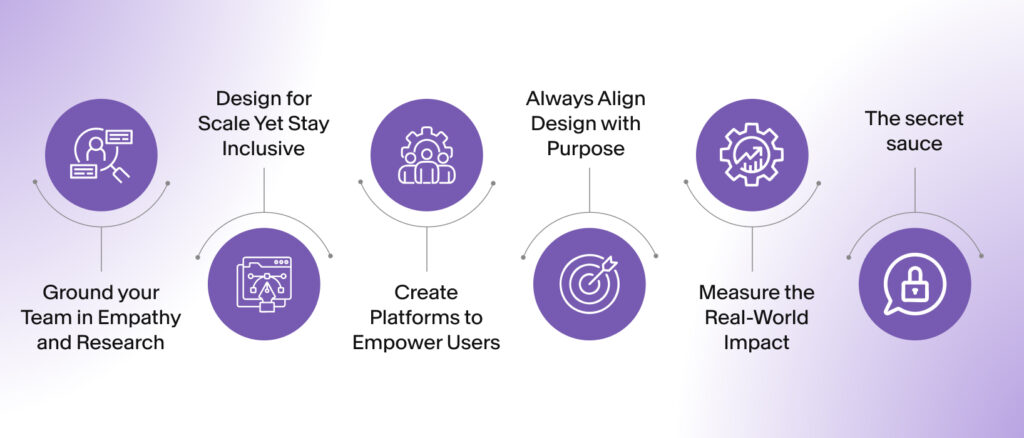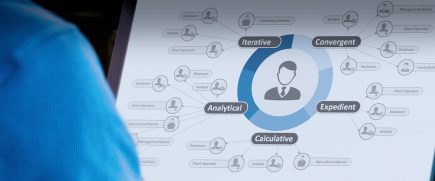UI/UX design, at its best, is not just about creating beautiful interfaces or friction-free user journeys, working toward an end goal for users. It’s about shaping lives through digital products. At Think Design, we believe that design carries the power to drive meaningful change, especially when applied to causes that touch society’s most pressing challenges—education, healthcare, and personal finance—in a way that considers the larger population across the globe. Over the years, our work with diverse organizations has reinforced one truth for everyone to witness: when design is empathetic, inclusive, and human-centred, it becomes a force for social good.
Stuti Mazumdar - September 2025

1. Ground Your Team in Empathy and Research
At the heart of designing for social good is empathy. We obviously go beyond assumptions and take the time to deeply understand the context deeply, including the business, industry, and end users. Our approach begins with research—immersing ourselves in the lives of users, learning about their daily struggles, aspirations, and cultural contexts. This allows us to create digital experiences that seamlessly integrate into their lives.
We conducted in-depth interviews with Loan Officers, Branch Managers, and stakeholders across 11 branches, ensuring that the redesigned loan origination system, loan management system, and customer portal addressed real-world pain points while also meeting business objectives. By capturing nuanced insights, we built tools that didn’t just streamline operations (which was our primary objective) but also empowered users seeking loans, many of whom were first-time users of such platforms, with usability and confidence.
2. Design for Scale Yet Stay Inclusive
Design for social good often demands balancing two critical aspects: scale and inclusivity. Projects in industries like education, healthcare, or financial services are often large-scale, need to go through heavy compliance checks, and involve millions of potential users across varied contexts. Yet the design must remain accessible to everyone, including those with limited digital literacy and ableness.
For instance, when we partnered with Bharti Airtel Foundation, the challenge was to redesign a teacher training app to serve one of India’s largest educational ecosystems. The solution needed to transform a dormant platform into an indispensable tool that teachers choose to use to actively upskill and engage. By leveraging familiar interaction patterns, micro-learning structures, and gamified elements, we created a platform that scaled nationally, driving 100,000+ teacher registrations and directly impacting the learning outcomes of over 3 million students.
3. Create Platforms To Empower Users
When we worked on LinQ Skills, a vocational training platform, our focus was to enhance accessibility while enabling learners to upskill effectively. The platform included features like a collaborative-learning architecture, multilingual accessibility, and micro-learning modules that respected users’ time and constraints. By introducing collaboration and bite-sized learning, we ensured that the design wasn’t just informative, but also empowering—turning users into active participants in their own development journeys driven by their personal schedules.

4. Always Align Design With Purpose
Healthcare is one of the most sensitive domains for social impact design. Here, every touchpoint can influence users’ awareness, trust, and even life-saving decisions. Our collaboration with ABT Associates exemplifies this.
The task was to design a healthcare toolkit to help primary healthcare providers and communities navigate maternal and child health challenges, abolishing delays in care provided for pneumonia and diarrhoea in infants in rural Bihar. Through participatory workshops and field immersion, we created tools that were not only practical but also culturally resonant. Visual cues and simplified language made the toolkit usable in low-resource settings. The result was a service design solution that bridged gaps between healthcare systems and the people they serve.
5. Measure The Real-World Impact

For us, success is not defined merely by a business metric that moved positively, a product shipped, or the number of features released. Success is measured by the change we enabled, the users we empowered, and the industry we moved.
Across the projects we briefly discussed above, the common thread has been measurable improvements in adoption, operational efficiency, and user empowerment. From simplifying daily tasks for the loan officers to driving collaborative learning in classrooms, we designed with metrics in mind that truly make a difference, going beyond numbers and looking at how experiences shift mindsets and enable dignity.
This commitment has also been recognized at an industry level. Our work for Bharti Foundation’s TheTeacherApp won the Best Design Project of at the India’s Best Design Awards, while also gaining recognition for Edtech Excellence at the BW Future of Design Awards. For us, this is validation for how purposeful design can deliver impact for the greater good.
6. The Secret Sauce
The key ingredient to our effectiveness in designing for social good is collaboration. We don’t see design as something we do to users or for organizations. Instead, we design with them. Whether it’s co-creating a classroom with teachers, conducting workshops with healthcare workers, or banding with branch managers in financial services for a field study, our process ensures that the people we design for are always active participants.



